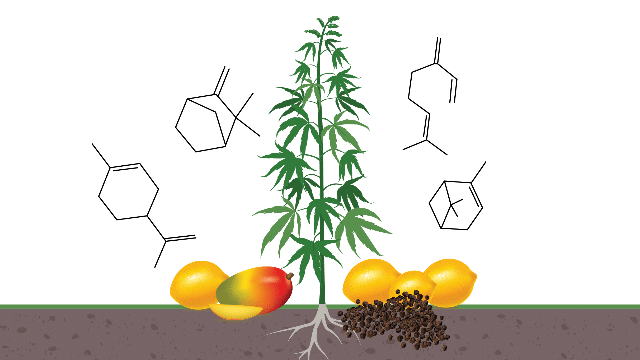What are terpenes?
You already know what terpenes are because you’ve experienced them all your life. Simply put, terpenes are what gives an orange its citrusy smell. They give pine trees their unique aroma. They’re even responsible for the relaxing effects in lavender. They are chemicals that determine how things smell.
But wait. You thought that cannabinoids were the compounds in the cannabis plant that caused healing, right? Yes, but it’s been discovered that terpenes can play a big role in that as well. In fact, cannabinoids and terpenes work together in something called the entourage effect.
The entourage effect simply means that cannabinoids such as THC and CBD, along with the hundreds of other compounds, along with the terpenes, are meant to work together. It’s the whole plant that does the best job, not just a single compound. While relief does come from using a CBD oil or a THC oil, whole plant therapy has been the most common use. Utilizing all the compounds and terpenes in the plant may just be the best way after all.
Terpenes can intensify or downplay the effects of the cannabinoids. Have you ever noticed how two similar strains can produce profoundly different effects? One may leave you with couch lock and the other may energize you? That’s another aspect of the entourage effect, which is driven by both cannabinoids and terpenes.
The terpene chart
Currently, there are at least 20,000 different terpenes in existence and the cannabis plant has more than 100 of these terpenes. Many terpenes that are produced by the cannabis plant are also found elsewhere in nature. However, there are a couple of terpenes that are in high concentrations in cannabis plants. Here are the ones to know.
Myrcene terpene
Myrcene, which can also be found in mangoes, is the primary terpene found in cannabis plants. In fact, some plants can have up to 65 percent of their terpene profile made up by myrcene alone. The presence of myrcene often determines whether a specific strain can be considered an indica or sativa. Plants with more than 0.5 percent myrcene are said to be indica. Myrcene is responsible for giving marijuana its distinctive aroma. Myrcene has relaxing properties as well as anti-inflammatory properties. Strains that are high in myrcene are Skunk XL, White Widow, and Special Kush.
Limonene terpene
The second most abundant terpene found in cannabis, limonene can also be found in various citrus fruits and is responsible for the citrusy smell. However, it may not be present in all cannabis strains. Limonene has powerful anti fungal and antibacterial properties, and its great smell means that it is a common additive in household cleaning and cosmetic products. Limonene can also help to bust stress and enhance mood. Strains high in Limonene include Sour Diesel and OG Kush as well as Super Lemon Haze.
Pinene terpene
This terpene’s name says it all, really. Pinene is found most abundantly in the pine tree and is what gives pine needles its distinctive smell. Found in two varieties, alpha, which is responsible for that wonderful pine aroma, and beta, which has a scent like rosemary, dill, or parsley. Pinene is a strong bronchodilator, but also has strong anti-inflammatory and antiseptic effects that have been used for centuries in herbal medicines. Pinene can be found in strains like Strawberry Cough and Blue Dream.
Linalool terpene
If you’ve ever used lavender for its relaxant effects, then you’re familiar with the terpene linalool. Linalool is widely known for the stress-relieving, anti-anxiety, and anti-depressant effects. Linalool can help to balance out the anxious side effect sometimes produced by THC and this makes it an ideal terpene for the treatment of anxiety. Linalool is present in strains like Special Kush, Amnesia Haze, and OG Shark.
Caryophyllene terpene
This terpene, which has a spicy, woody, peppery scent, is also found in black pepper and cinnamon. Studies indicate that this one small terpene is capable of performing the big job of treating anxiety, depression, and inflammation. Caryophyllene is found in such strains as Super Silver Haze, Skywalker, and Rock Star.
Humulene terpene
While many other strains help to increase appetite, which is beneficial to those who have conditions which nausea and loss of appetite are a factor, strains that contain humulene may actually help to decrease appetite. Found in hops, cloves, and basil, humulene has also shown anti-inflammatory and antibacterial properties in research. Strains which contain humulene include Liberty Haze, Girl Scout Cookies, and Sour Diesel.
As said, cannabis contains some 100 known terpenes, all of which produce their own effects. Combined with the cannabinoids and other terpenes, the future of cannabis may just be in the cultivation of strains rich in certain terpenes and cannabinoids to create strains tailored to produce certain effects.
Vaporizing and terpenes
Carbonization destroys many of the terpenes, just like it destroys many of the cannabinoids. Because of this, using a portable vaporizer with temperature control is probably the best way to get the most out of the terpenes found in cannabis. Like cannabinoids, terpenes have their own individual optimal temperature, and these temps can vary widely. Researching the various temperatures at which the terpenes you desire to be released is key in achieving the desired effect.
Terpenes and cannabinoids are two compounds found in cannabis that when used together help produce a synergistic effect. Selecting strains based upon the terpenes’ effects can help you to achieve the result you desire.

